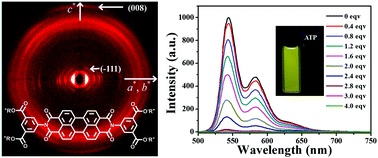Perylene diimide derivative via ionic self-assembly: helical supramolecular structure and selective detection of ATP†
Abstract
A novel perylene diimide material (perylene diimide tetracid–dihexadecyldimethylammonium bromide, PDTA–DHAB) with a unique hierarchical structure was designed and prepared by an ionic self-assembly (ISA) method. The self-assembly behavior and aggregated structure of the complex were then studied by a variety of techniques such as UV-Vis absorption spectra, differential scanning calorimetry, and two-dimensional X-ray diffraction. With the presence of a rigid linkage, the complex can self-assemble into highly ordered helical columns which further pack into a monoclinic crystalline lattice with dimensions of a = 4.02 nm, b = 3.40 nm, c = 2.90 nm, α = β = 90°, γ = 92°. During heating, the helical supramolecular structure was destroyed and transformed to a lamellar liquid crystalline phase. Furthermore, the complex solution upon the addition of ATP showed a remarkable absorption and fluorescence intensity decrease compared with other anions. These results will provide insight into the rational design of functional materials with a helical supramolecular structure through the ISA method.



 Please wait while we load your content...
Please wait while we load your content...